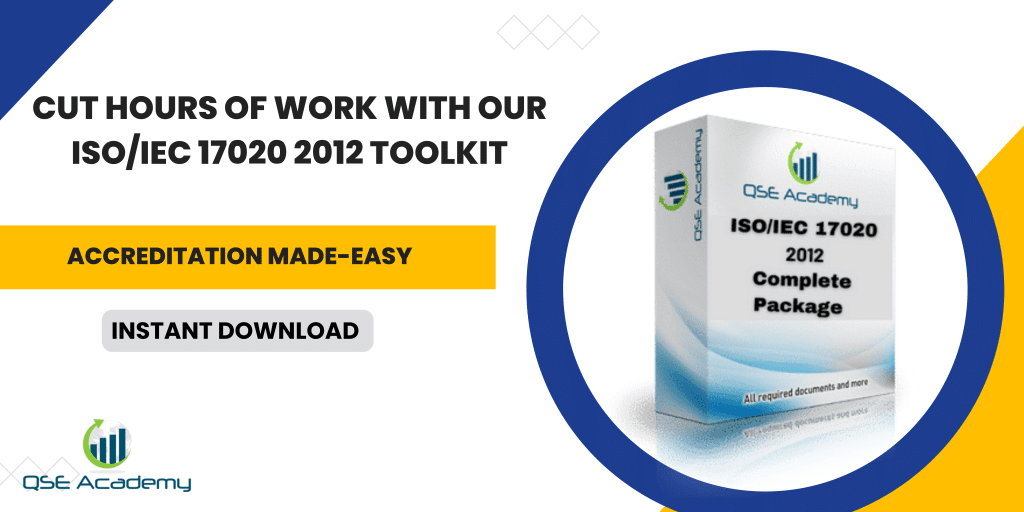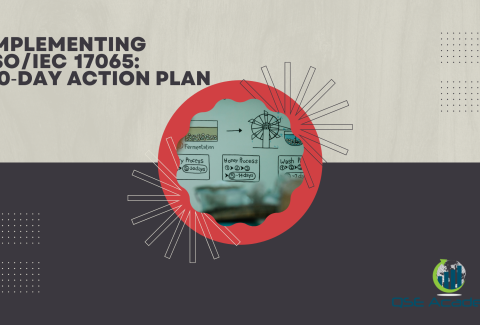ISO/IEC 17020 Corrective Actions for Audit Findings

ISO/IEC 17020 Corrective Actions for Audit Findings
Last Updated on October 22, 2025 by Hafsa J.
Why Corrective Actions Define Your ISO/IEC 17020 Success
Let’s be honest—no one enjoys seeing the word “non-conformity” in an audit report. But here’s the truth: those findings aren’t there to punish you; they’re there to help you improve. In ISO/IEC 17020 accreditation, what really matters isn’t whether you had findings—it’s how you handle them.
In my experience working with inspection bodies preparing for ISO/IEC 17020 assessments, I’ve seen one clear pattern: the organizations that treat corrective actions as more than just paperwork always come out stronger. They don’t rush to patch the issue—they dig deep, find the root cause, fix the system, and prove it works. That mindset is what separates inspection bodies that merely pass audits from those that build sustainable compliance and credibility.
This article walks you step-by-step through how to manage ISO/IEC 17020 corrective actions for audit findings—from understanding what a corrective action really is, to documenting, implementing, and verifying it effectively. You’ll learn how to:
-
Identify the real cause behind non-conformities (not just the symptom).
-
Respond to assessors with clear, evidence-based plans.
-
Verify that your fixes actually work—and stay that way.
-
Turn your audit feedback into continuous improvement opportunities.
If you’ve ever felt overwhelmed after receiving audit findings, this guide is for you. Let’s start by clarifying exactly what a corrective action means under ISO/IEC 17020—and why it’s much more than just fixing a mistake.
Understanding Corrective Actions in ISO/IEC 17020 Audits
Here’s what I’ve noticed after helping dozens of inspection bodies navigate accreditation: many teams confuse “fixing” a problem with correcting its cause. They address the symptom, send proof to the assessor, and move on—only for the same issue to reappear during the next audit. That happens because they’ve applied a correction, not a true corrective action.
In ISO/IEC 17020 terms, the distinction matters.
A correction restores compliance temporarily (for example, recalibrating an expired instrument).
A corrective action goes deeper—it removes the root cause that allowed that lapse to happen (like creating a calibration tracking log and assigning responsibility).
And a preventive action ensures similar problems never occur again.
Here’s how the three levels differ:
| Term | Meaning | Example |
|---|---|---|
| Correction | The immediate fix to restore compliance. | Calibrate an overdue instrument. |
| Corrective Action | The action taken to eliminate the root cause of the problem. | Assign equipment custodian, create calibration reminder system. |
| Preventive Action | The action that prevents a similar issue from arising. | Add calibration review to quarterly internal audit checklist. |
Pro Tip:
When assessors review your corrective actions, they look for depth of thought. If your response only addresses what happened—not why it happened—it won’t pass.
Common Pitfall:
Many inspection bodies stop at the correction level because it feels faster. But without identifying the cause, the same issue will surface again, often as a major non-conformity next time.
Now that we’ve clarified what corrective actions truly mean in ISO/IEC 17020, let’s move to the next step—which types of audit findings typically require them, and how to prioritize your response.
Common Types of Audit Findings Requiring Corrective Actions
Here’s the reality: not every audit comment needs a corrective action—but when assessors flag a non-conformity, you can’t afford to take it lightly. Some findings are simple oversights, while others point to deeper system weaknesses that can threaten impartiality, competence, or consistency. Understanding which types of findings require structured corrective actions helps you prioritize and respond effectively.
Based on years of ISO/IEC 17020 audit experience, here are the most frequent findings that trigger corrective actions and how they usually arise:
| Area / Clause | Typical Audit Finding | Likely Root Cause | Action Needed |
|---|---|---|---|
| 4.1 – Impartiality | No documented impartiality risk analysis or missing committee meeting records. | Oversight in planning or unclear ownership of impartiality review. | Assign impartiality committee lead, schedule annual review, and document outcomes. |
| 5.1 – Personnel Competence | Outdated training records or unclear authorization matrix. | No formal process to track qualifications and re-assessments. | Implement competence matrix and establish review intervals. |
| 5.3 – Equipment and Calibration | Calibration certificates expired or missing traceability to standards. | Poor tracking or lack of defined responsibility for calibration control. | Create calibration log with reminders and assign custodian. |
| 5.2 – Inspection Methods | Methods not validated or procedures outdated. | No structured review or validation cycle in place. | Introduce validation plan with annual review dates. |
| 8.6 – Internal Audit & Management Review | Internal audit incomplete or no documented follow-up on findings. | Internal audits done as formality, not as evaluation tool. | Use clause-based checklist and ensure actions are reviewed in management meetings. |
Pro Tip:
Keep an Audit Findings Tracker that consolidates all non-conformities—internal and external—in one sheet. Include the clause, root cause, action owner, deadline, and verification date. It’s one of the first things assessors look for during surveillance visits.
Common Pitfall:
Treating minor findings as “not urgent.” Small issues—like a missing training record—often signal process gaps that can lead to major findings later. Always analyze the root cause, even for low-risk findings.
Now that you know which types of findings call for structured corrective actions, let’s break down how to manage the entire process step by step—from identification to closure.
Step-by-Step Process for Handling ISO/IEC 17020 Corrective Actions
Here’s what I tell every inspection body I work with: the moment you receive your audit report, your response timeline begins. The way you handle findings—how structured, traceable, and evidence-based your actions are—says more about your system maturity than the findings themselves. Assessors want to see a clear, methodical process that turns feedback into improvement.
Below is a practical six-step framework you can apply to every ISO/IEC 17020 audit finding:
| Step | Action | Purpose / Output |
|---|---|---|
| 1. Record the Finding | Copy the exact statement from the audit report, including clause reference and classification (major/minor). | Prevents misinterpretation and ensures your response matches the assessor’s observation. |
| 2. Analyze the Root Cause | Use the “5 Whys” or Fishbone method to uncover the real reason behind the issue. | Identifies the system failure—not just the surface mistake. |
| 3. Plan the Corrective Action | Define what will be done, who will do it, and by when. Prioritize based on risk and impact. | Ensures accountability and structure. |
| 4. Implement and Document Evidence | Update procedures, train staff, correct affected records, and gather proof (signatures, logs, reports). | Provides objective evidence of actual change. |
| 5. Verify Effectiveness | After one cycle, check if the issue reappears or related errors persist. Conduct a follow-up review or internal audit. | Confirms the problem is solved at the source. |
| 6. Record and Communicate Results | Log actions in your corrective-action register and report them during the next management review. | Creates transparency and continuous oversight. |
Pro Tip:
Always attach tangible proof. Assessors don’t just want to hear that you’ve corrected something—they want to see it. Include updated procedures, training attendance sheets, calibration certificates, or screenshots of your new tracking systems.
Common Pitfall:
Teams often stop after step 4, assuming implementation equals closure. It doesn’t. Without step 5 (effectiveness verification), you can’t demonstrate improvement. A non-conformity is only considered closed when you have evidence that the issue hasn’t recurred.
Next, let’s go deeper into root-cause analysis techniques—because without identifying the true cause, every corrective action risks being just another temporary fix.
Root-Cause Analysis Techniques for ISO/IEC 17020 Findings
Here’s the key difference between a quick fix and a real solution: a true corrective action starts with understanding the root cause. You can’t improve what you don’t fully understand. Most recurring ISO/IEC 17020 findings trace back to weak or incomplete root-cause analysis — where teams stop at “human error” or “lack of attention” instead of identifying why the system allowed the error to happen in the first place.
Root-cause analysis doesn’t have to be complex, but it does need to be structured. Here are a few proven methods that work well for inspection bodies:
| Technique | How It Works | When to Use It | Example in ISO/IEC 17020 Context |
|---|---|---|---|
| 5 Whys Method | Ask “Why?” repeatedly (at least five times) until you uncover the underlying process or system weakness. | For simple, well-defined issues. | Finding: Calibration overdue → Why? No reminder system → Why? No responsible person → Why? No defined procedure → Why? Lack of management review of calibration plan → Root cause: Missing process ownership. |
| Fishbone (Ishikawa) Diagram | Visual tool that breaks down possible causes into categories like Methods, People, Equipment, Environment, and Management. | For complex or recurring issues with multiple possible factors. | Useful for analyzing inconsistent inspection results or competence gaps. |
| Cause-and-Effect Table | Tabular version linking each possible cause to evidence and likelihood. | For audits with several findings connected to one process. | Helpful for clustering issues like documentation control or impartiality risks. |
Pro Tip:
When you reach “human error” as a cause—don’t stop. Ask what in the system allowed that error to occur. Was training insufficient? Were responsibilities unclear? Was supervision missing? Root causes are always system-related, not person-blaming.
Common Pitfall:
Skipping documentation. Many teams discuss causes informally but fail to record their reasoning. Always document your analysis—it becomes valuable audit evidence and shows assessors that your system learns and evolves.
Once you’ve identified the root cause, the next step is to document and submit your corrective-action report in a way that satisfies accreditation bodies and reflects professionalism. Let’s go through exactly how to do that next.
Writing and Submitting Corrective-Action Reports to the Accreditation Body
Here’s what assessors often say: “It’s not the finding that worries us—it’s how the organization responds.” A well-written corrective-action report shows maturity, structure, and control. It tells the accreditation body, “We understand the issue, we’ve fixed the cause, and we can prove it.” Unfortunately, many inspection bodies rush their responses, producing vague, generic replies that raise more questions than confidence.
To stand out and avoid back-and-forth clarifications, your corrective-action report should follow a clear, evidence-based format.
| Section | What to Include | Example |
|---|---|---|
| 1. Reference Information | Non-conformity number, ISO/IEC 17020 clause, and audit type (initial, surveillance, reassessment). | NC #05 – Clause 5.3: Equipment and Calibration (Surveillance Audit) |
| 2. Non-Conformity Statement | Copy the exact text from the audit report (do not paraphrase). | “Calibration certificates for pressure gauges lacked traceability to national standards.” |
| 3. Root-Cause Analysis Summary | Describe the real reason behind the issue, supported by evidence. | Calibration tracking delegated informally; no defined ownership or review schedule. |
| 4. Corrective Action Plan | Outline what actions will be taken, who is responsible, and the deadline. | Assign calibration custodian; establish register; set 3-month review cycle (Responsible: Technical Manager, Deadline: May 15). |
| 5. Evidence of Implementation | Attach supporting records, logs, training documents, or updated procedures. | New calibration register (signed and dated), procedure QP-05 Rev.2 attached. |
| 6. Verification of Effectiveness | Describe how you’ll confirm the fix works. | Follow-up internal audit to verify calibration log compliance in July 2025. |
Pro Tip:
Keep your responses concise but complete—no more than one page per finding, plus attachments. Accreditation bodies prefer clear, structured reports over lengthy narratives.
Common Pitfall:
Submitting reports without evidence. Updating a procedure or assigning responsibility isn’t enough—you must show implementation. Include copies, logs, training attendance sheets, or screenshots of updated registers.
Once you’ve submitted your corrective-action report, the assessor will review it for adequacy and effectiveness. But the work doesn’t stop there—you still need to prove that your actions worked. Let’s look at how to verify effectiveness in a way that demonstrates full control and confidence.
Verifying and Demonstrating the Effectiveness of Corrective Actions
Here’s where many inspection bodies fall short: they implement corrective actions, submit their reports, and then move on—without ever checking if the fix actually worked. But to an assessor, a corrective action isn’t “closed” until there’s proof of effectiveness. The goal isn’t just to patch the issue, it’s to show that the system now prevents it from recurring.
Effectiveness verification should be systematic, measurable, and documented. Here’s how to approach it:
| Verification Step | Purpose | Example of Evidence |
|---|---|---|
| 1. Define Verification Criteria | Establish what success looks like. | “No calibration overdue for 3 months” or “All inspectors have current competence evaluations.” |
| 2. Schedule a Review or Re-Audit | Conduct a targeted internal audit or spot check after implementation. | Follow-up audit of equipment register after 90 days. |
| 3. Gather Objective Evidence | Collect data, logs, or observations proving sustained improvement. | Updated calibration records, inspection forms, or new audit reports. |
| 4. Document the Results | Record the findings of your verification in a Corrective-Action Log. | “Verification completed July 20, 2025 – all equipment verified as current.” |
| 5. Include Results in Management Review | Ensure management is aware and monitors trends. | Present summary of closed findings and system improvements. |
Pro Tip:
Keep a Corrective-Action Effectiveness Register that tracks all follow-ups. This document is gold during surveillance audits—it shows the accreditation body that you not only respond to findings but also verify long-term control.
Common Pitfall:
Declaring effectiveness too early. It takes at least one operational cycle (a few months or a full audit round) to confirm a fix has held. Assessors can tell when verification is rushed or superficial.
Effectiveness Verification Checklist:
- Evidence of implementation (procedure, record, or training)
- Time passed to demonstrate sustained control
- Objective verification (audit or observation)
- Documentation of review and approval
- Discussion of results in management review
Once you’ve mastered verification, your corrective-action system becomes more than just a compliance requirement—it becomes a living part of your continual improvement process.
Next, let’s look at how to turn these corrective actions into a preventive culture that keeps your inspection body ahead of audit findings year after year.
Preventive Culture: Turning Corrective Actions into Continuous Improvement
Here’s something I’ve learned after working with dozens of accredited inspection bodies: the strongest organizations don’t wait for audit findings to improve—they use corrective actions as springboards for prevention. Once a problem has been fixed and verified, the next question should always be: “How can we make sure this never happens again?” That mindset is what transforms compliance into genuine continual improvement.
A preventive culture under ISO/IEC 17020 means shifting from reactive control to proactive awareness. Every staff member—auditors, inspectors, managers—becomes part of a system that spots risks before they turn into findings.
Here’s how to build that culture step by step:
| Preventive Strategy | Why It Works | Practical Example |
|---|---|---|
| Integrate Lessons Learned | Turns past findings into training material. | Review last audit’s non-conformities during quarterly team meetings. |
| Trend Analysis | Detects recurring weak areas before assessors do. | Track audit data by clause; address clauses that reappear often. |
| Routine Micro-Audits | Keeps the system alive between formal audits. | Every month, audit one process (e.g., calibration control). |
| Management Review Follow-Through | Ensures actions don’t fade after meetings. | Include “open corrective actions” as a permanent review item. |
| Encourage Staff Feedback | Empowers employees to report risks early. | Create a simple online form for staff to log system gaps or improvement ideas. |
Pro Tip:
Document every improvement—no matter how small. When assessors see consistent updates in your procedures, logs, and review minutes, they recognize a living management system that evolves with evidence, not last-minute preparation.
Common Pitfall:
Treating prevention as an abstract concept. Prevention isn’t theory—it’s embedded in small, routine habits: timely record updates, cross-checks, and clear communication. The more embedded those habits are, the fewer surprises appear during audits.
In essence, effective corrective actions should always lead to preventive awareness. When your organization consistently learns from its own findings, non-conformities become rare—and improvement becomes automatic.
Next, let’s wrap up this guide with a few quick FAQs about corrective actions in ISO/IEC 17020 audits—the kind of questions assessors often hear and inspection bodies frequently ask.
FAQs – ISO/IEC 17020 Corrective Actions and Audit Management
Q1: How much time do we have to close corrective actions after an audit?
Most accreditation bodies give between 30 and 60 days to submit and implement corrective actions after receiving the audit report. However, timely responses make a strong impression—start working on your plan within the first week. If the issue is complex, communicate your progress transparently and request a realistic timeline extension rather than rushing incomplete evidence.
Q2: What’s the difference between a correction, corrective action, and preventive action?
-
A correction fixes the immediate problem (e.g., calibrating an overdue instrument).
-
A corrective action removes the root cause that allowed the problem to occur (e.g., adding calibration tracking and assigning ownership).
-
A preventive action ensures similar issues never happen elsewhere in the system (e.g., incorporating calibration checks into quarterly audits).
Assessors expect to see all three reflected in your response, especially for recurring issues.
Q3: How do assessors verify that corrective actions were effective?
They’ll look for evidence of sustainability. Expect them to review updated records, observe implementation during site visits, or check your internal-audit results. If a finding has reappeared in multiple cycles, it signals that your previous corrective action wasn’t effective.
Q4: Can we reuse a corrective action format from ISO 9001 for ISO/IEC 17020?
Yes, but adapt it. ISO 9001 focuses on quality management, while ISO/IEC 17020 emphasizes impartiality, technical competence, and inspection consistency. Make sure your template includes fields for clause reference, risk impact, technical validation, and evidence verification—those are essential under ISO/IEC 17020.
Q5: What tools can help track corrective actions efficiently?
A simple Excel tracker or digital log works fine if it’s structured. Include columns for:
-
Non-conformity description and clause reference
-
Root cause summary
-
Corrective and preventive actions
-
Responsible person and due date
-
Verification status and closure date
Many accredited bodies use this as their “Corrective-Action Register,” which assessors often request to review.
Conclusion & Next Steps
Here’s the reality: how you manage corrective actions defines the strength of your ISO/IEC 17020 system. Every audit finding—whether major or minor—is an opportunity to improve how your inspection body operates. The real test of competence isn’t whether you receive findings, but how effectively you respond to them.
Strong organizations share one habit: they treat corrective actions as part of their continuous improvement rhythm, not as post-audit chores. They identify causes, fix processes, verify results, and feed lessons back into daily operations. That’s what transforms an ISO/IEC 17020 system from “compliant” to capable.
By now, you’ve learned how to:
-
Understand what corrective actions truly mean under ISO/IEC 17020.
-
Distinguish between corrections, corrective, and preventive actions.
-
Apply a structured six-step process for handling findings.
-
Perform proper root-cause analysis using 5 Whys or Fishbone tools.
-
Write clear, evidence-based corrective-action reports.
-
Verify effectiveness and build a preventive, improvement-driven culture.
If you put this into practice, your next accreditation audit will feel less like an inspection and more like a confirmation of control and maturity.
Ready to take the next step?
-
Download the ISO/IEC 17020 Corrective-Action Tracker Template to manage findings systematically.
-
Explore the ISO/IEC 17020 Documentation & Audit Toolkit to strengthen your procedures and evidence logs.
-
Or enroll in the ISO/IEC 17020 Corrective-Action & Root-Cause Analysis Masterclass to train your team in real-world audit handling and improvement strategies.
At its core, ISO/IEC 17020 is about trust—and nothing builds trust faster than a system that learns from its own findings and improves continuously. Your corrective actions are more than audit responses; they’re the foundation of lasting accreditation success.
I hold a Master’s degree in Quality Management, and I’ve built my career specializing in the ISO/IEC 17000 series standards, including ISO/IEC 17025, ISO 15189, ISO/IEC 17020, and ISO/IEC 17065. My background includes hands-on experience in accreditation preparation, documentation development, and internal auditing for laboratories and certification bodies. I’ve worked closely with teams in testing, calibration, inspection, and medical laboratories, helping them achieve and maintain compliance with international accreditation requirements. I’ve also received professional training in internal audits for ISO/IEC 17025 and ISO 15189, with practical involvement in managing nonconformities, improving quality systems, and aligning operations with standard requirements. At QSE Academy, I contribute technical content that turns complex accreditation standards into practical, step-by-step guidance for labs and assessors around the world. I’m passionate about supporting quality-driven organizations and making the path to accreditation clear, structured, and achievable.
Related Posts
ISO/IEC 17065 Overview: What It Is and Why It Matters
ISO/IEC 17065 Requirements: Clause‑by‑Clause Breakdown
Implementing ISO/IEC 17065: 90‑Day Action Plan
Cart
Recent Posts
Subscribe on YouTube










